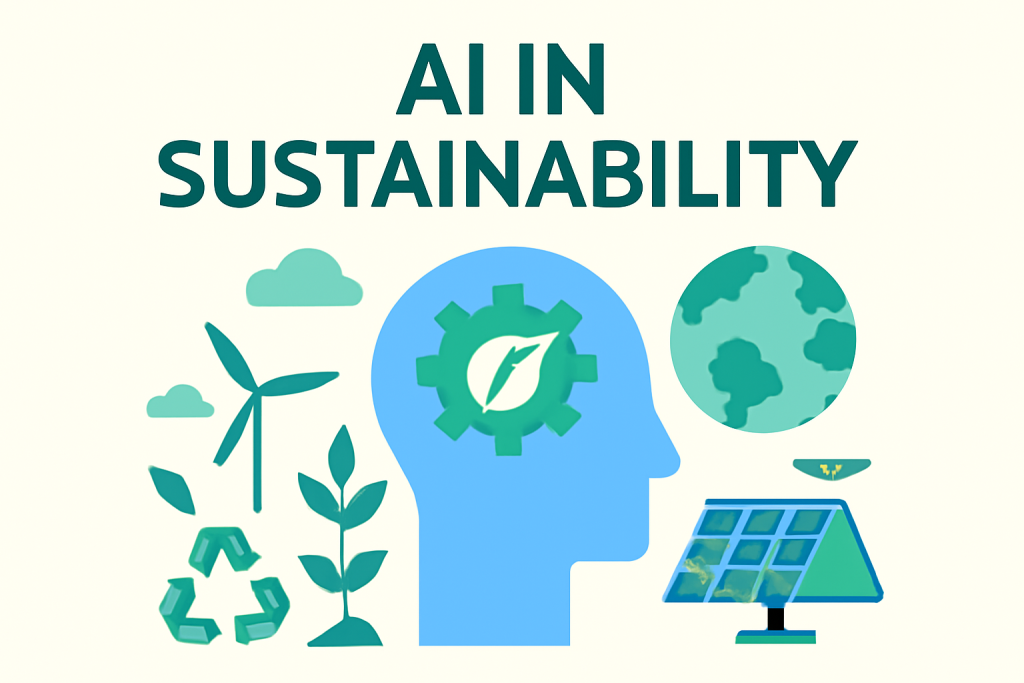
In today’s rapidly evolving world, where the effects of climate change, resource depletion, and environmental degradation are more pronounced than ever, the need for sustainable solutions has never been greater. Traditional approaches to sustainability are often limited by human capabilities and the vastness of environmental data. However, artificial intelligence (AI) is emerging as a powerful tool to address these challenges, offering innovative and scalable solutions that were once unimaginable.
AI’s role in sustainability is not just theoretical; it’s happening now. From optimizing energy usage to protecting wildlife and improving agricultural practices, AI is transforming how we understand and solve environmental challenges. This blog explores the ways AI is helping to pave the way towards a more sustainable, eco-friendly future.
1. Climate Change Monitoring and Prediction
The reality of climate change is no longer a distant threat—it’s here, and it’s accelerating. AI plays a crucial role in monitoring climate data and predicting future patterns, which is essential for informed decision-making in tackling climate change.
Predicting Weather Patterns and Natural Disasters
AI models have the ability to analyze vast amounts of data from various sources—satellites, sensors, and climate models—to predict weather patterns and natural disasters with much greater accuracy. For example, AI is used to predict hurricanes, droughts, and floods, helping governments and organizations take preventative measures.
Example: IBM’s Climate Impact Analysis
IBM has developed AI models that track and predict climate impact, helping businesses and governments make data-driven decisions on climate risks. Their AI tools analyze historical weather data and forecast future climate events, allowing for better preparation and risk mitigation strategies.
Carbon Emission Tracking
AI can analyze data from sensors in cities, factories, and transportation systems to monitor and predict carbon emissions. By identifying the largest sources of pollution, AI allows for more effective policies and interventions to reduce emissions.
2. Enhancing Energy Efficiency
Energy consumption is a significant contributor to global greenhouse gas emissions. As the demand for energy grows, so does the need for smarter, more efficient energy usage. AI is stepping in to optimize energy consumption across industries, households, and even entire cities.
Smart Grids and Energy Systems
AI is integral to the development of smart grids, which use machine learning algorithms to balance electricity supply and demand, ensuring that energy is distributed efficiently. AI can predict energy consumption patterns and make real-time adjustments to prevent energy waste.
Example: Google’s DeepMind and Energy Efficiency
Google’s DeepMind team used AI to optimize the cooling systems in Google’s data centers, reducing energy consumption by 40%. This AI-driven optimization helps reduce the carbon footprint of large-scale data operations, showing how AI can be a game-changer in reducing energy waste in tech industries.
Energy Management in Buildings
AI-powered systems can control the energy consumption of buildings by regulating lighting, heating, and air conditioning based on occupancy patterns. These smart buildings adapt to environmental changes in real-time, reducing energy waste and making buildings more sustainable.
3. Promoting Sustainable Agriculture
Agriculture is one of the largest contributors to environmental degradation, including deforestation, water waste, and excessive pesticide use. AI is revolutionizing farming practices, making them more sustainable, efficient, and less harmful to the environment.
Precision Agriculture
AI-driven technologies like drones, satellite imaging, and IoT sensors are used to gather real-time data on soil conditions, crop health, and weather patterns. This data is analyzed by AI algorithms to optimize water usage, fertilizer application, and pest control.
Example: IBM Watson Decision Platform for Agriculture
IBM’s Watson Decision Platform leverages AI to provide farmers with real-time insights on everything from weather forecasts to soil conditions. By helping farmers make better decisions, this platform improves crop yields while minimizing environmental impacts like water waste and pesticide use.
Reducing Waste and Overproduction
AI can predict crop yields and market demand, helping farmers reduce overproduction, which leads to waste. It can also optimize supply chains, ensuring that food is distributed efficiently without unnecessary waste. AI can analyze patterns in consumer demand and help farmers adjust production schedules accordingly.
4. Wildlife Conservation and Biodiversity Protection
Biodiversity loss is a significant environmental challenge, with many species facing extinction due to habitat destruction, poaching, and climate change. AI is playing an increasingly important role in wildlife conservation efforts.
Poaching Prevention and Surveillance
AI-powered cameras and drones are used in conservation areas to monitor wildlife and detect illegal activities like poaching. These systems use AI algorithms to analyze footage and identify potential threats, such as humans or vehicles, even in remote or hard-to-reach areas.
Example: Wildtrack’s AI for Wildlife Conservation
Wildtrack has developed an AI system that analyzes wildlife footprints to track animal movements and monitor populations. This technology helps conservationists identify trends in animal behavior and detect poaching activities in real-time, ensuring faster responses to threats.
Habitat Mapping and Restoration
AI is also used to map and restore wildlife habitats. Machine learning algorithms can analyze satellite images to identify areas that need restoration or protection. This can be particularly helpful in monitoring deforestation or identifying areas for reforestation.
5. Sustainable Waste Management and Circular Economy
The world is producing more waste than ever, and much of it ends up in landfills or pollutes oceans and rivers. AI is helping us shift towards a circular economy, where materials are reused, recycled, and repurposed rather than discarded.
Smart Waste Sorting
AI-powered robots and machines are being used to sort recyclables from waste more efficiently than human workers. These systems use computer vision and deep learning algorithms to identify different types of materials, such as plastics, metals, and paper, and sort them accordingly.
Example: AMP Robotics
AMP Robotics has developed AI-driven robots that can identify and sort recyclable materials in waste streams. These robots improve the efficiency of recycling centers and reduce the amount of waste sent to landfills.
Waste-to-Energy Technology
AI is also helping convert waste into energy through advanced waste-to-energy plants. By optimizing the combustion and conversion processes, AI ensures that waste is efficiently turned into usable energy, reducing the environmental impact of traditional waste disposal methods.
6. AI and Sustainable Transportation
Transportation is another major contributor to global carbon emissions, with vehicles, ships, and airplanes emitting pollutants that contribute to climate change. AI is helping to develop smarter, greener transportation solutions.
Electric Vehicles (EVs) and Smart Charging
AI plays a key role in optimizing the use of electric vehicles (EVs) and their charging infrastructure. By predicting demand and adjusting charging times, AI helps reduce the load on power grids while ensuring that EVs are charged efficiently.
Autonomous and Shared Transportation
AI-powered autonomous vehicles and ride-sharing platforms can reduce emissions by improving traffic flow, reducing unnecessary fuel consumption, and encouraging the use of shared transport.
Example: Tesla’s AI-Driven Energy Ecosystem
Tesla’s AI-powered systems not only optimize electric vehicle performance but also integrate with renewable energy solutions like solar panels and Powerwall to create a sustainable energy ecosystem. By managing energy consumption intelligently, Tesla reduces dependence on fossil fuels and promotes the use of clean energy.
7. AI for Water Conservation
Water scarcity is a growing problem in many parts of the world. AI is helping to conserve water resources by optimizing water usage in agriculture, industry, and urban areas.
Smart Irrigation Systems
AI-powered irrigation systems use data from weather forecasts, soil sensors, and satellite imaging to optimize water use in agriculture. These systems ensure that crops receive the right amount of water, reducing waste and conserving water resources.
Leak Detection and Water Management
AI is also used in urban water management systems to detect leaks and optimize water distribution. Machine learning algorithms can analyze data from sensors in pipelines to identify leaks and prevent water wastage.
Conclusion: AI’s Role in the Future of Sustainability
AI is no longer a futuristic technology—it is actively shaping the future of sustainability. From reducing carbon emissions and protecting biodiversity to optimizing energy use and improving agricultural practices, AI is helping to solve some of the most pressing environmental challenges of our time.
As AI technology continues to evolve, its potential to drive further environmental change is boundless. By harnessing the power of AI, we can accelerate the transition to a more sustainable world—one where technology and nature coexist in harmony.
With AI leading the charge, we can be optimistic about building a sustainable future for generations to come.


Leave a Reply